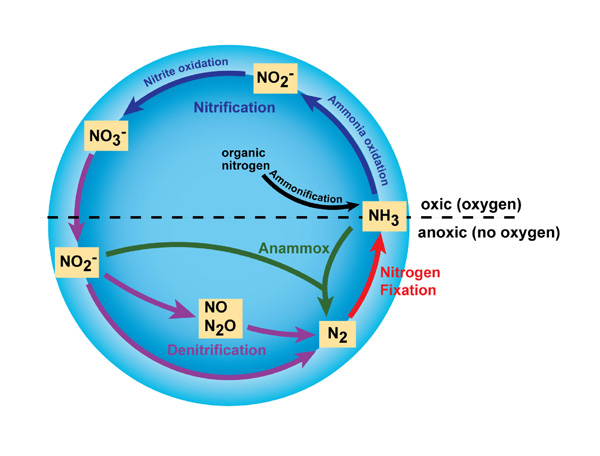Which of the Following Genera Is Capable of Nitrogen Fixation
Some of the free-living nitrogen fixers are Azotobacter Beijernickia Rhodospirillum cyanobacteria etc. Nitrogen fixing bacteria Nitrogen fixing bacteria are classified according to their mode of fixation.

Important Nitrogen Fixing Cyanobacterial Genera Download Scientific Diagram
It grows on organic nutrients.

. Four genera in italics three tribes and the. The reduction of nitrogen gas to ammonia is called nitrogen fixationcycling. View chapter Purchase book.
Examples of symbiotic nitrogen fixers are Rhizobium in the root nodules of legumes and Frankia in the root nodules of non-leguminous plants etc. Synthesis of amino acids. Rhizobium and Bradyrhizobium are not capable of doing so.
The conversion of N 2 into ammonia occurs at a metal cluster called FeMoco an abbreviation for th. A variety of types of bacteria are capable of nitrogen fixation including heterotrophs cyanobacteria and other photoautotrophs and chemo-autotrophs. Blue-green bacteria are free-living photosynthetic microbes that fix nitrogen in aquatic habitats and moist soil including the genera Anabaena Nostoc and Calothrix.
Nitrogen-fixing bacteria microorganisms capable of transforming atmospheric nitrogen into fixed nitrogen inorganic compounds usable by plants. Free living N fixers capable of fixing mol. In contrast to members of the two other genera Azorhizobium is capable of growing with atmospheric nitrogen in its free living state.
Multiple Choice Cyanobacteria actinobacterie and proteobecteria ere common prokeryotic nitrogen-fixing symbionts Legumes form nodules containing bacteria collectively celled rhizobia e form symbioses with many shrub species Nitrogen-fixing cyanobecteria form underground nodules in their host plents The plants provide organic nutrients to the bacteria and the. Nitrogen fixation occurs when these plants are in the symbiotic state and the agents of fixation are soil bacteria from the genera Rhizobium Bradyrhizobium Sinorhizobium Mesorhizobium Azorhizobium and Allorhizobium the traditional rhizobia from the alpha-Proteobacteria as well as some more recently discovered genera that lie phylogenetically outside this group. Two kinds of nitrogen-fixing bacteria are recognized.
All of the following organisms are capable of nitrogen fixation EXCEPT __________. In inland waters heterotrophic bacteria and cyanobacteria are responsible for most of the nitrogen fixation that occurs. Members of the genus Rhizobium A.
Long-term studies show a 42 decrease in soil nitrogen 25 years following disturbance. The main species used include genus mucuna Crotolaria Dolichos and desmodium. Decomposition of amino acids.
In inland waters heterotrophic bacteria and cyanobacteria are responsible for most of the nitrogen fixation that occurs. The rates of nitrogen fixation and the resulting new nitrogen input to an ecosystem from this process vary greatly and are controlled by a number of physical chemical and ecological factors related to both the internal characteristics of a water body and. Which of the following genera grow symbiotically within root nodules of legumes as nitrogen-fixing bacteroids.
More than 90 percent of all nitrogen fixation is effected by these organisms which thus play an important role in the nitrogen cycle. The groups of bacteria which have the ability to fix nitrogen from air to soil are Most soil protozoa are flagellates or amoebas having their dominant mode of nitrogen as. Strains of these microbes also live in mutualisms with certain fungi in a symbiosis known as lichens which have an ability to fix nitrogen.
Infect broad-leaved plants and cause crown gall disease. Nitrogen fixation is carried by physicochemical and biological means. Bacteria in the genus Cytophaga are capable of digesting a wide range of complex carbohydrates and are important for degrading raw sewage.
A variety of types of bacteria are capable of nitrogen fixation including heterotrophs cyanobacteria and other photoautotrophs and chemo-autotrophs. Biological nitrogen fixation BNF occurs when atmospheric nitrogen is converted to ammonia by a nitrogenase enzyme. N 2 to cellular N independently of other living organism.
The first kind the free-living nonsymbiotic bacteria. Members of which of the following genera are the most common sexually transmitted bacteria in the United States. Rhizobia are more prominent in the rhizosphere of leguminous plants.
Are free living soil bacteria that fix nitrogen. The overall reaction for BNF is. O it sometimes occurs in bacteria that are mutualistic symbionts in plant roots it is one of several metabolic processes that make atmospheric nitrogen available for use by other organisms O it is a process that occurs exclusively in some species of prokaryotes some species of cyanobacteria have specialized nitrogen-fixing cells O it is the metabolic process that converts N2 to NH3.
Associative N fixers 3. Only 10 of natural nitrogen fixation takes place by physicochemical means whereas 90 is carried out by biological means. Rhizobium is a free-living Gram negative nonsporulating aerobic and motile rod shaped bacterium 05-09mm x 12 - 3mm which resides in soil and is capable of infection nodulation establishing symbiosis and N 2 fixation.
Endophytic N fixers 4. Grow symbiotically in root nodules of legumes where they fix nitrogen. Non-biological or Physical nitrogen fixation.
Thus we can classify nitrogen fixation in following two types. None of the listed choices. The process is coupled to the hydrolysis of 16 equivalents of ATP and is accompanied by the co-formation of one equivalent of H 2.
Rhizobia are the first group of organism realized for its potential of nitrogen fixation. Oxidation of sulfide for energy. Herbaceous legume cover crops have been observed to produce enough N inputs through biological nitrogen fixation BNF to meet the needs of subsequent maize crop.
Decomposition of amino acids. Are important nitrifying bacteria that convert nitrite to nitrate.

The Nitrogen Cycle Processes Players And Human Impact Learn Science At Scitable

Different Types Of Nitrogen Fixing Associations With Plants The Three Download Scientific Diagram

The Three Groups Of Nitrogen Fixing Organisms Including Some Main Download Scientific Diagram

The Three Groups Of Nitrogen Fixing Organisms Including Some Main Download Scientific Diagram
No comments for "Which of the Following Genera Is Capable of Nitrogen Fixation"
Post a Comment